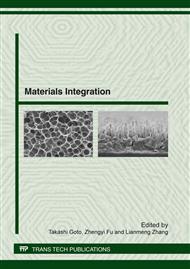[1]
C.P. Firme III, P.R. Bandaru, Toxicity issues in the application of carbon nanotubes to biological systems, Nanomedicine: NBM 6 (2010) 245–256.
DOI: 10.1016/j.nano.2009.07.003
Google Scholar
[2]
H. Dumortier, S. Lacotte, G. Pastorin, R. Marega, W. Wu, D. Bonifazi, Functionalized carbon nanotubes are non-cytotoxic and preserve the functionality of primary immune cells, Nano Lett. 6 (2006) 1522-1528.
DOI: 10.1021/nl061160x
Google Scholar
[3]
A. Nimmagadda, K. Thurston, M.U. Nollert, P.S.J. McFetridge, Chemical modification of SWNT alters in vitro Cell-SWNT interactions, Biomed. Mater. Res. 76A (2006) 614-625.
DOI: 10.1002/jbm.a.30577
Google Scholar
[4]
S. Murugesan, T.J. Park, H. Yang, S. Mousa, R.J. Linhardt, Blood compatible carbon nanotubes − nano-based neoproteoglycans, Langmuir 22 (2006) 3461-3463.
DOI: 10.1021/la0534468
Google Scholar
[5]
W. Wu, S. Wieckowski, G. Pastorin, M. Benincasa, C. Klumpp, J.P. Briand, Targeted delivery of amphotericin B to cells by using functionalized carbon nanotubes, Angew Chem. Int. Ed. 44 (2005) 6358 –6362.
DOI: 10.1002/anie.200501613
Google Scholar
[6]
Z. Liu, X. Sun, N. Nakayama-Rathford, H. Dai, Supramolecular chemistry on water-soluble carbon nanotubes for drug loading and delivery, ACS Nano 1 (2007) 50-56.
DOI: 10.1021/nn700040t
Google Scholar
[7]
W. Wu, R. Li, X. Bian, Z. Zhu, D. Ding and X. Li, Covalently combining carbon nanotubes with anticancer agent: preparation and antitumor activity, ACS Nano 39 (2009) 2740–2750.
DOI: 10.1021/nn9005686
Google Scholar
[8]
H. Ali-Boucetta, K.T. Al-Jamal, D. McCarthy, M. Prato, A. Bianco, K. Kostarelos, Multiwalled carbon nanotube–doxorubicin supramolecular complexes for cancer therapeutics, Chem. Commun. (2008) 459-461.
DOI: 10.1039/b712350g
Google Scholar
[9]
S. Park, N. Mohanty, J.W. Suk, A. Nagaraja, J.H. An, R.D. Piner, Biocompatible, robust free-standing paper composed of a TWEEN/graphene composite, Adv. Mater. 22 (2010) 1736-1740.
DOI: 10.1002/adma.200903611
Google Scholar
[10]
Y.B. Zhang, S.F. Ali, E. Dervishi, Y. Xu, Z.R. Li, D. Casciano, Cytotoxicity effects of graphene and single-wall carbon nanotubes in neural phaeochromocytoma-derived PC12 cells, ACS Nano 4 (2010) 3181-3186.
DOI: 10.1021/nn1007176
Google Scholar
[11]
K.S. Novoselov, A.K. Geim, S.V. Morozov, D. Jiang, Y. Zhang, S.V. Dubonos, I.V. Grigorieva, A.A. Firsov, Electric Field Effect in Atomically Thin Carbon Films, Science, 306(2004) 666-669.
DOI: 10.1126/science.1102896
Google Scholar
[12]
X. Sun, Z. Liu, K. Welsher, J.T. Robinson, A. Goodwin, S. Zaric, H. Dai, Nano-Graphene Oxide for Cellular Imaging and Drug Delivery. Nano Res. 1 (2008) 203-212.
DOI: 10.1007/s12274-008-8021-8
Google Scholar
[13]
Z. Liu, J.T. Robinson, X. Sun, N. Nakayama-Rathford, H. Dai, PEGylated nanographene oxide for delivery of water-insoluble cancer drugs, J. Am. Chem. Soc. 130 (2008) 10876-10877.
DOI: 10.1021/ja803688x
Google Scholar
[14]
Y. Wang, Z. Li, D. Hu, C.T. Lin, J. Li, Y. Lin, Aptamer/graphene oxide nanocomplex for in situ molecular probing in living cells, J. Am. Chem. Soc. 132 (2010) 9274-6.
DOI: 10.1021/ja103169v
Google Scholar
[15]
C.H. Lu, C.L. Zhu, J. Li, J.J. Liu, X. Chen, H.H. Yang, Using graphene to protect DNA from cleavage during cellular delivery, Chem. Commun. 46 (2010) 3116-8.
DOI: 10.1039/b926893f
Google Scholar
[16]
X. Yang, X. Zhang, Z. Liu, Y. Ma, Y. Huang, Y. Chen, High-Efficiency Loading and Controlled Release of Doxorubicin Hydrochloride on Graphene Oxide, J. Phys. Chem. C 112 (2008) 17554–17558.
DOI: 10.1021/jp806751k
Google Scholar
[17]
Y. Cao, S. Liu, Q. Shen, K. Yan, P.J. Li, J. Xu, D.P. Yu, M.L. Steigerwald, C. Nuckolls, Z.F. Liu, X.F. Guo, High-Performance Photoresponsive Organic Nanotransistors with Single-Layer Graphenes as Two-Dimensional Electrodes, Adv. Funct. Mater. 19 (2009).
DOI: 10.1002/adfm.200900408
Google Scholar
[18]
H.J. Salavagione, M.A. Gomez, G. Martinez, Polymeric Modification of Graphene through Esterification of Graphite Oxide and Poly(vinyl alcohol), Macromolecules 42 (2009) 6331–6334.
DOI: 10.1021/ma900845w
Google Scholar
[19]
L. Zhang, J. Xia, Q. Zhao, L. Liu, Z. Zhang, Functional graphene oxide as a nanocarrier for controlled loading and targeted delivery of mixed anticancer drugs, Small 6 (2010) 537-544.
DOI: 10.1002/smll.200901680
Google Scholar
[20]
V.K. Rana, M.C. Choi, J.Y. Kong, G.Y. Kim, M.J. Kim, S.H. Kim, S. Mishra, R.P. Singh, C.S. Ha, Synthesis and Drug-Delivery Behavior of Chitosan-Functionalized Graphene Oxide Hybrid Nanosheets, Macromol. Mater. Eng. 296 (2011) 131–140.
DOI: 10.1002/mame.201000307
Google Scholar
[21]
N.G. Sahoo, H. Bao, Y. Pan, M. Pal, M. Kakran, H.K.F. Cheng, L. Li, L.P. Tan, Functionalized carbon nanomaterials as nanocarriers for loading and delivery of a poorly water-soluble anticancer drug: A comparative study, Chem. Commun. 47 (2011).
DOI: 10.1039/c1cc00075f
Google Scholar
[22]
M. Kakran, N.G. Sahoo, H. Bao, Y. Pan, L. Li, Functionalized graphene oxide as nanocarrier for loading and delivery of ellagic acid, Curr. Med. Chem. 18 (2011) 4503-4512.
DOI: 10.2174/092986711797287548
Google Scholar



